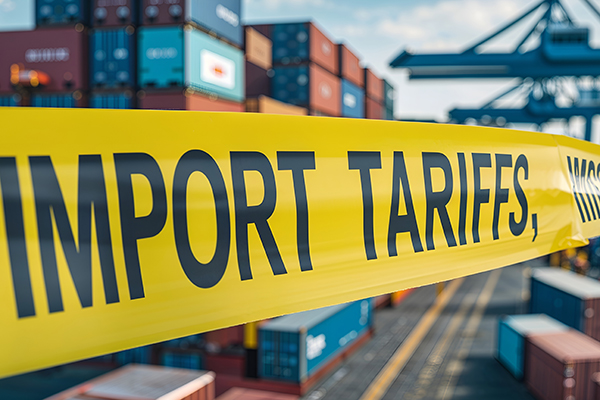
As many as 100 governments around the world have indicated an interest in negotiating tariffs with the Trump administration following the rapid series of trade policy announcements by President Donald Trump.
The President’s Wednesday, April 2, “Liberation Day” announcement of new reciprocal tariffs from the first Rose Garden ceremony was followed by uncertainty, higher consumer prices, lower stock market prices and reduced consumer confidence.
Just a week later, on Wednesday, April 9, the President announced a “90-day pause” of the reciprocal tariffs — except China, which was raised to 125% resulting in a 145% total, and keeping the 10% tariff on other countries.
According to the White House fact sheet, President Trump imposed responsive tariffs to “strengthen the international economic position of the United States and protect American workers.”
As the basis to impose these tariffs, the President invoked his authority under the International Emergency Economic Powers Act of 1977 (IEEPA) to “address the national emergency posed by the large and persistent trade deficit that is driven by the absence of reciprocity in our trade relationships and other harmful policies like currency manipulation and exorbitant value-added taxes (VAT) perpetuated by other countries.”
Trade Negotiations
Now quickly negotiating trade deals is everyone from Vice President JD Vance traveling to India, U.S. Treasury Secretary Scott Bessent attending the annual spring International Monetary Fund (IMF) and World Bank (WB) meetings in Washington, D.C., to U.S. Trade Representative Ambassador Jamieson Greer.
Italy’s Prime Minister has visited the White House to discuss a European perspective and there have been discussions with Japan, as well as more recently with South Korea and the United Kingdom. President Trump has taken a personal interest in attempting to negotiate with China. The focus has been on top U.S. trading partners with 18 proposals on the table, but there are many more country negotiations to come.
Negotiating all these agreements in short order is a monumental task, particularly because there are only approximately 250 employees in the office of the U.S. Trade Representative. For the near future, some of the agreements may be more in the form of memorandums of understanding.
In the meantime, the IMF has slashed its global growth forecast for this year and predicts a big impact on the U.S. economy. The IMF states that U.S. growth is expected to slow to 1.8% in 2025 with the global economy projected to grow by 2.8%, compared to 3.3% last year.
New Tariffs Summary
- President Trump imposed a 10% tariff on all countries, effective April 5, 2025.
- Before announcing the 90-day pause on tariffs, President Trump planned to impose an individualized reciprocal higher tariff on the countries with which the United States has the largest trade deficits, with all other countries continuing to be subject to the original 10% tariff baseline — effective April 9, 2025. See list of countries.
- The tariffs were to remain in effect until President Trump determines that the threat posed by the trade deficit and underlying nonreciprocal treatment is satisfied, resolved, or mitigated.
- The executive order also contains “modification authority,” allowing the President to increase the tariff if trading partners retaliate or decrease the tariffs if trading partners take significant steps to remedy nonreciprocal trade arrangements and align with the United States on economic and national security matters.
- Some goods are not subject to the reciprocal tariffs, including steel/aluminum articles and autos/auto parts already subject to Section 232 tariffs; copper, pharmaceuticals, semiconductors, and lumber articles; bullion; and energy and certain other minerals not available in the United States.
- For Canada and Mexico, the existing fentanyl/migration IEEPA orders remain in effect, and are unaffected by the April 2 executive order. This means that United States-Mexico-Canada Agreement (USMCA)-compliant goods will continue to see a 0% tariff and non-USMCA-compliant goods will see a 25% tariff.
California Actions
Meanwhile in California, Governor Gavin Newsom on April 4 directed his administration to pursue new strategic trade relationships with international partners aimed at strengthening shared economic resilience and protecting California’s manufacturers, workers, farmers, businesses, and supply chains.
As part of this effort, the Governor also called on longstanding trade partners to exempt California-made products from any retaliatory measures, reinforcing the state’s commitment to fair, open, and mutually beneficial trade.
On April 14, Governor Newsom and Visit California announced the state will be launching a new international campaign to help maintain the strong tourism partnership between California and Canada, reminding Canadians that California is a grateful partner and remains one of the best — and most welcoming — destinations in the United States, and the world.
On April 16, Governor Newsom and Attorney General Rob Bonta filed a lawsuit in federal court challenging President Trump’s use of emergency powers to enact broad-sweeping tariffs that hurt states, consumers, and businesses. The lawsuit argues that President Trump lacks the authority to unilaterally impose tariffs through the IEEPA, creating immediate and irreparable harm to California, the largest economy, manufacturing, and agriculture state in the nation.
CalChamber Statement
In response to ongoing news and announcements related to the federal administration’s actions on tariffs, and the Governor and Attorney General’s lawsuit challenging such actions, CalChamber President and CEO Jennifer Barrera issued the following statement:
“CalChamber has long supported a free trade agenda that fosters economic growth and job creation, including advocacy on lowering or eliminating tariff and non-tariff barriers for businesses. Protectionist measures, such as tariffs, disrupt global supply chains and raise costs on businesses, which are ultimately reflected through higher consumer prices or limited choices on products. As Californians grapple with rising costs and worry about daily pocketbook issues, additional tariffs will only further exacerbate the affordability crisis that millions are facing and will have dire consequences on the California economy.”
CalChamber Position
The California Chamber of Commerce, in keeping with longstanding policy, enthusiastically supports free trade worldwide, expansion of international trade and investment, fair and equitable market access for California products abroad and elimination of disincentives that impede the international competitiveness of California business.
While strategic use of tariffs or the threat of tariffs may be a meaningful negotiation tool, the CalChamber supports efforts to reduce the taxation and regulatory burden as a means to create jobs and economic growth. Further, a focus on trade agreements instead will ultimately eliminate both tariff and non-tariff barriers and help create long-term, sustainable economic growth.
The CalChamber supports negotiating new multilateral, sectoral and regional trade agreements, ensuring that the United States may continue to gain access to world markets, resulting in an improved economy and additional employment of Americans.

